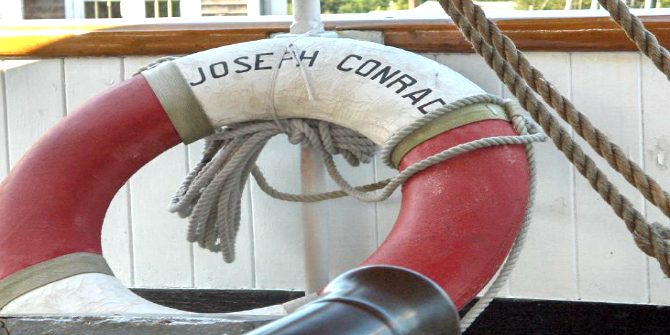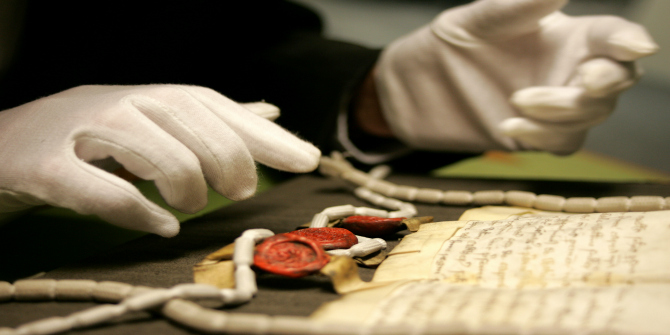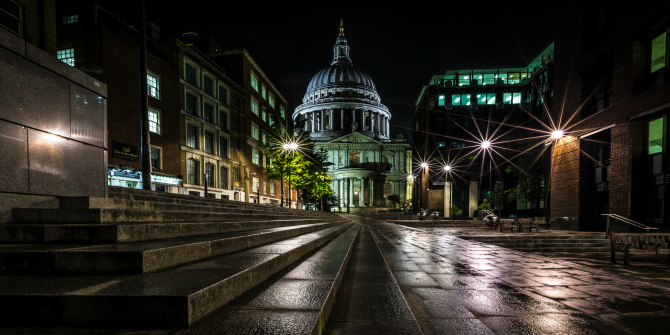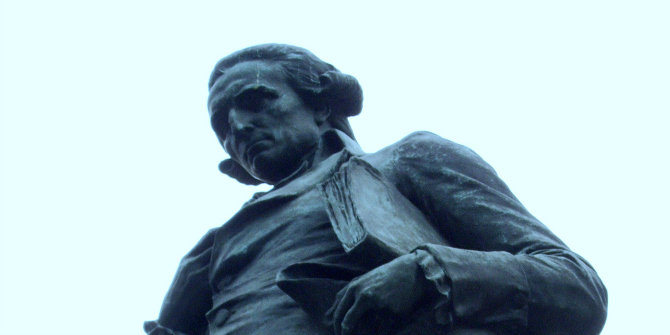In Balloon Madness: Flights of Imagination in Britain, 1783-1786, Clare Brant explores the booming popularity of the hot air balloon in Britain following the launch of a technology that made possible the dream of human flight. Full of lively personalities and striking anecdotes drawn from Brant’s thorough archival research, this book is a fascinating and comprehensive account of the impact of ‘balloonomania’ on British print and visual culture, writes Jason Pearl.
Balloon Madness: Flights of Imagination in Britain, 1783-1786. Clare Brant. Boydell and Brewer. 2017.
Find this book (affiliate link): ![]()
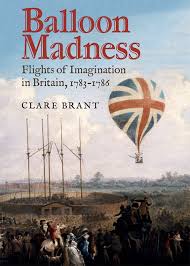
People went a little mad in 1783 when the advent of ballooning made possible the age-old dream of human flight. Rather, a lot mad. Hence the title of Clare Brant’s new book, Balloon Madness: Flights of Imagination in Britain, 1783-1786. Invented in France by the papermakers Joseph-Michel and Jacques-Étienne Montgolfier, the hot air balloon incited a major technological fad that quickly crossed the English Channel and spread throughout Europe and over to North America.
‘Balloons occupy senators, philosophers, ladies, everybody,’ Horace Walpole scoffed. Demonstrations drew some of the biggest crowds ever assembled, including 150,000 on 15 September 1784 to watch Vincenzo Lunardi earn the title of the first to fly in Britain. Ticketholders got closest, but these were inclusive spectacles, and everyone could catch a glimpse once the balloon achieved a certain height. There were indeed senators, philosophers and ladies, but also pickpockets and ruffians, and in the event of technical difficulties – a common problem – the crowd might riot, burning the balloon and wrecking the equipment and scaffolding.
What Walpole called ‘balloonomania’ rippled through almost every aspect of British society. It was a major achievement in science and engineering with a host of conjectured applications, yet the phenomenon surpassed all this, sparking new trends in diverse branches of cultural production. There were balloon-themed hats and dresses and umbrellas. A flood of prints commemorated notable ascensions. Satirists used balloons to mock financial bubbles and the hot air of politicians. New novels featured balloon-borne adventurers who travelled the Earth and even visited the Moon.
Brant digs deep in the archives, bringing to light obscure manuscripts and forgotten newspaper stories. Others have looked at aerostation either more narrowly or broadly, focusing on specific balloonists or following a trajectory of discovery and achievement throughout the world or over the centuries. Here, in contrast, we get a comprehensive account of three years in Britain, where the balloon craze rose swiftly, soared high in the sky, then fell back to Earth when even the more sanguine promoters started to realise these contraptions were impossible to steer and good for almost nothing practical. Ballooning would never be as popular or culturally significant again. This explains our preoccupation instead with the history of ‘heavier-than-air’ aircraft, the Wright brothers and Sir George Cayley. Still, the initial impact of balloon flight was enormous, and no one before has so fully presented its effects on print and visual culture in Britain.
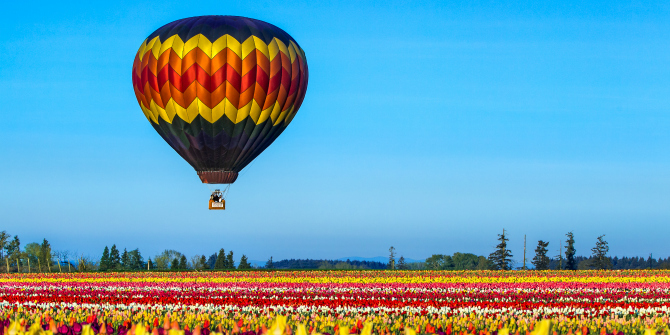 Image Credit: ‘Up, up, and away’ by Sheila Sund licensed under CC BY 2.0.
Image Credit: ‘Up, up, and away’ by Sheila Sund licensed under CC BY 2.0.
Brant’s book teems with anecdotes about lively personalities and hilarious mishaps. There’s Lunardi, the Italian showman, a man of feeling, handsome, genteel, beloved by masses of English women. There’s the Irishman Richard Crosbie, wearer of flashy costumes and designer of a boat-shaped vessel with rotating panels on the sides purported to facilitate steering. And there were innumerable schemes and rivalries, accidents and near misses. One con man promised a violin melody while descending via parachute; he got nervous and jumped a mere ten feet from the ground, breaking his instrument and quickly running off. Jean-Pierre Blanchard and John Jeffries, the first to cross the Channel, would have failed had they not thrown everything overboard, including their clothes, and still they descended, until both leaned over and urinated, which finally did the trick and allowed the balloon to rise.
All these details are buttressed by two major claims. First, that balloons inspired, in the words of the subtitle, ‘flights of imagination’, in addition to flights of the body, enabling a range of new creative possibilities. Second, that ‘they were also vehicles for values, and with ideological ballast’ (11). Hence two major sections of the book, ‘Levity’ and ‘Gravity’, each with a cluster of chapters.
Fashion, satire and literature more broadly expressed the airier feelings of the balloon craze. Consumers bought clothes, fans, china, furniture and snuff boxes, all emblazoned with balloon imagery, and soon their popularity was associated with femininity and effeminacy. Satirists mocked the phenomenon but found a useful symbol for political arguments against Whigs and Tories alike. Novelists, meanwhile, now had new ways to transport characters; poets, new ways to imagine transcendence. But Brant, a scholar of literature, shows how existing genres were adapted, how old forms were modernised, not abolished, by the new technology. Thus, James Thomson’s The Seasons, published sixty years earlier in 1730, is part of a continuous history of aerial perspectives in topographic poetry.
Among Brant’s weightier concerns are representations of ballooning for ideological ends. Lofty and spectacular, here was a readymade symbol for kings, especially in pre-revolutionary France. George III, for his part, expressed interest in the underlying scientific principles. And ballooning was a means for nationalism and national self-definition: at first, the English derided the invention simply because it was French; then, with aeronauts at home, they changed their minds, taking great pride in James Sadler, the first Briton to fly. From the beginning, there were plans to use balloons in warfare to bring back reconnaissance or bombard enemies behind fortified walls. Joseph-Michel Montgolfier is said to have dreamed of the capture of Gibraltar by balloon assault. Yet all this pulls against an undercurrent of cosmopolitanism: Lunardi, of course, was a foreigner; both French and British flags were hung for the joint ascent of Blanchard and John Sheldon. The aerial view, moreover, shows us how people from different places are connected, how human-made borders are artificial, how the world looks smaller from above than it feels below.
Indeed, the balloon prospect is one of the book’s recurring themes. In a chapter on the sublime, Brant considers how the aerial perspective impinged on aesthetics, driving new theorisations of beauty and sublimity. Up above, roads and buildings looked beautifully small rather than sublimely large, and the experience was often described as peaceful instead of terrifying. At the same time, balloonists could not but be humbled by the immensity of the natural world, by the vast clouds before them and the land- and seascapes stretching to the horizon.
In the final chapter, a sort of epilogue, Brant turns to the longer history of ballooning and its legacy in art, film and literature, linking the first aerial views to the environmental photography of Yann Arthus-Bertrand and Alex MacLean. She points out that balloons were never instruments of power or domination: ‘There’s no panoptic control here; there’s a risk of loss of control’ (217). Very true, though historians sometimes portray ballooning as the first step on the way to satellite surveillance and drone warfare. The balloon craze was unlike anything else, before or after, and future efforts too failed to find practical uses. Still, there remains something at least philosophically useful in the balloon prospect: the ideal of seeing at a distance, with a greater sense of scale but without a sense of mastery, taking in more of the world without taking control of it.
Note: This review gives the views of the author, and not the position of the LSE Review of Books blog, or of the London School of Economics. The LSE RB blog may receive a small commission if you choose to make a purchase through the above Amazon affiliate link. This is entirely independent of the coverage of the book on LSE Review of Books.



